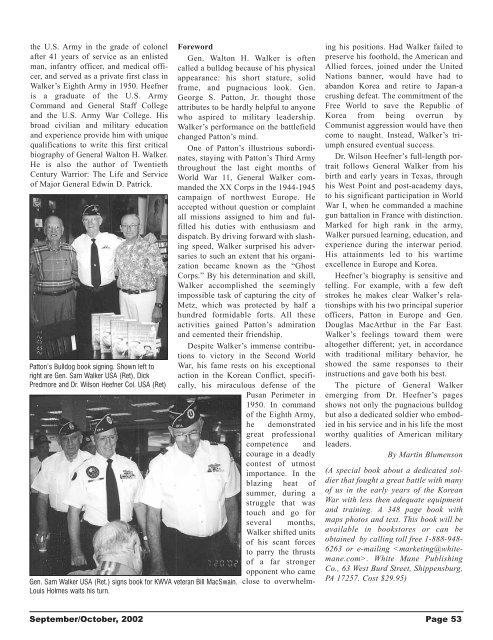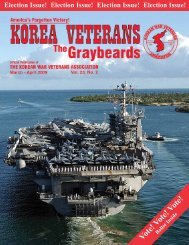The Graybeards – KWVA - Korean War Veterans Association
The Graybeards – KWVA - Korean War Veterans Association
The Graybeards – KWVA - Korean War Veterans Association
Create successful ePaper yourself
Turn your PDF publications into a flip-book with our unique Google optimized e-Paper software.
the U.S. Army in the grade of colonel<br />
after 41 years of service as an enlisted<br />
man, infantry officer, and medical officer,<br />
and served as a private first class in<br />
Walker’s Eighth Army in 1950. Heefner<br />
is a graduate of the U.S. Army<br />
Command and General Staff College<br />
and the U.S. Army <strong>War</strong> College. His<br />
broad civilian and military education<br />
and experience provide him with unique<br />
qualifications to write this first critical<br />
biography of General Walton H. Walker.<br />
He is also the author of Twentieth<br />
Century <strong>War</strong>rior: <strong>The</strong> Life and Service<br />
of Major General Edwin D. Patrick.<br />
Patton’s Bulldog book signing. Shown left to<br />
right are Gen. Sam Walker USA (Ret), Dick<br />
Predmore and Dr. Wilson Heefner Col. USA (Ret)<br />
Gen. Sam Walker USA (Ret.) signs book for <strong>KWVA</strong> veteran Bill MacSwain.<br />
Louis Holmes waits his turn.<br />
Foreword<br />
Gen. Walton H. Walker is often<br />
called a bulldog because of his physical<br />
appearance: his short stature, solid<br />
frame, and pugnacious look. Gen.<br />
George S. Patton, Jr. thought those<br />
attributes to be hardly helpful to anyone<br />
who aspired to military leadership.<br />
Walker’s performance on the battlefield<br />
changed Patton’s mind.<br />
One of Patton’s illustrious subordinates,<br />
staying with Patton’s Third Army<br />
throughout the last eight months of<br />
World <strong>War</strong> 11, General Walker commanded<br />
the XX Corps in the 1944-1945<br />
campaign of northwest Europe. He<br />
accepted without question or complaint<br />
all missions assigned to him and fulfilled<br />
his duties with enthusiasm and<br />
dispatch. By driving forward with slashing<br />
speed, Walker surprised his adversaries<br />
to such an extent that his organization<br />
became known as the “Ghost<br />
Corps.” By his determination and skill,<br />
Walker accomplished the seemingly<br />
impossible task of capturing the city of<br />
Metz, which was protected by half a<br />
hundred formidable forts. All these<br />
activities gained Patton’s admiration<br />
and cemented their friendship.<br />
Despite Walker’s immense contributions<br />
to victory in the Second World<br />
<strong>War</strong>, his fame rests on his exceptional<br />
action in the <strong>Korean</strong> Conflict, specifically,<br />
his miraculous defense of the<br />
Pusan Perimeter in<br />
1950. In command<br />
of the Eighth Army,<br />
he demonstrated<br />
great professional<br />
competence and<br />
courage in a deadly<br />
contest of utmost<br />
importance. In the<br />
blazing heat of<br />
summer, during a<br />
struggle that was<br />
touch and go for<br />
several months,<br />
Walker shifted units<br />
of his scant forces<br />
to parry the thrusts<br />
of a far stronger<br />
opponent who came<br />
close to overwhelm-<br />
ing his positions. Had Walker failed to<br />
preserve his foothold, the American and<br />
Allied forces, joined under the United<br />
Nations banner, would have had to<br />
abandon Korea and retire to Japan-a<br />
crushing defeat. <strong>The</strong> commitment of the<br />
Free World to save the Republic of<br />
Korea from being overrun by<br />
Communist aggression would have then<br />
come to naught. Instead, Walker’s triumph<br />
ensured eventual success.<br />
Dr. Wilson Heefner’s full-length portrait<br />
follows General Walker from his<br />
birth and early years in Texas, through<br />
his West Point and post-academy days,<br />
to his significant participation in World<br />
<strong>War</strong> I, when he commanded a machine<br />
gun battalion in France with distinction.<br />
Marked for high rank in the army,<br />
Walker pursued learning, education, and<br />
experience during the interwar period.<br />
His attainments led to his wartime<br />
excellence in Europe and Korea.<br />
Heefner’s biography is sensitive and<br />
telling. For example, with a few deft<br />
strokes he makes clear Walker’s relationships<br />
with his two principal superior<br />
officers, Patton in Europe and Gen.<br />
Douglas MacArthur in the Far East.<br />
Walker’s feelings toward them were<br />
altogether different; yet, in accordance<br />
with traditional military behavior, he<br />
showed the same responses to their<br />
instructions and gave both his best.<br />
<strong>The</strong> picture of General Walker<br />
emerging from Dr. Heefner’s pages<br />
shows not only the pugnacious bulldog<br />
but also a dedicated soldier who embodied<br />
in his service and in his life the most<br />
worthy qualities of American military<br />
leaders.<br />
By Martin Blumenson<br />
(A special book about a dedicated soldier<br />
that fought a great battle with many<br />
of us in the early years of the <strong>Korean</strong><br />
<strong>War</strong> with less then adequate equipment<br />
and training. A 348 page book with<br />
maps photos and text. This book will be<br />
available in bookstores or can be<br />
obtained by calling toll free 1-888-948-<br />
6263 or e-mailing .<br />
White Mane Publishing<br />
Co., 63 West Burd Street, Shippensburg,<br />
PA 17257. Cost $29.95)<br />
September/October, 2002 Page 53

















